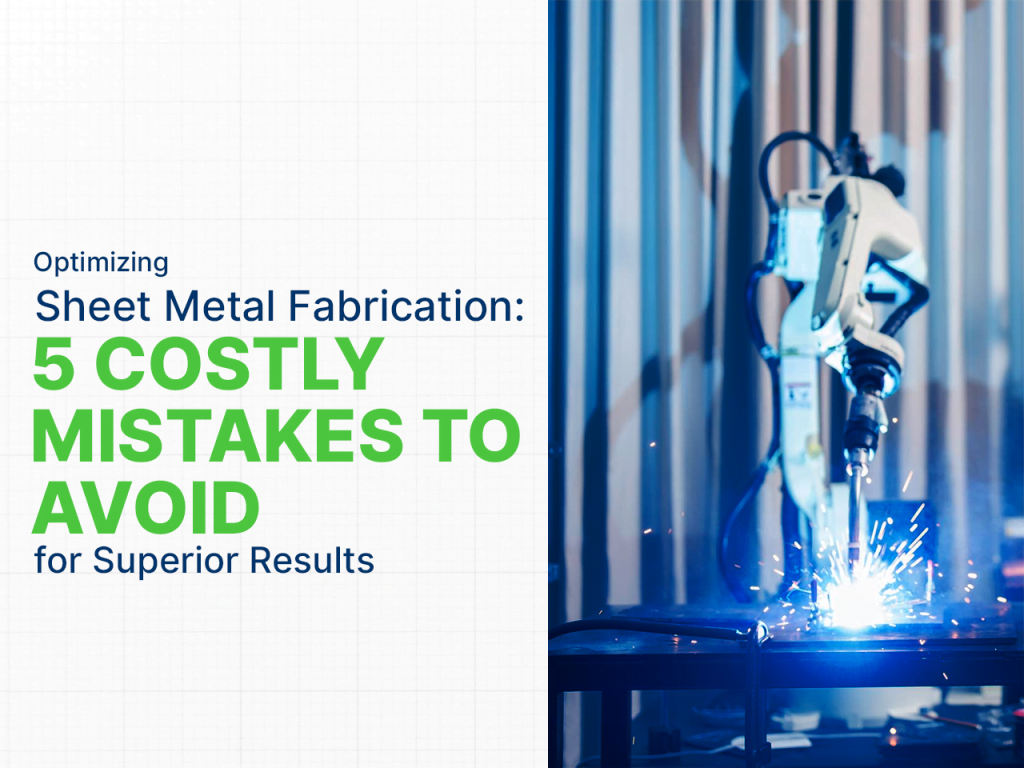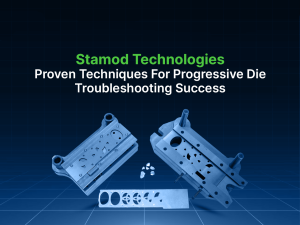Introduction
In today’s rapidly evolving and technologically advanced world, precision and efficiency are paramount in sheet metal fabrication. Every mistake can result in costly delays and quality issues that affect your bottom line. At STAMOD Technologies, we understand the importance of flawless sheet metal fabrication, and we’re here to share our expertise on the subject. In this blog, we’ll explore five common costly mistakes in sheet metal fabrication and provide valuable insights on how to avoid them. Throughout this article, you’ll also discover how STAMOD Technologies can be your strategic partner in achieving excellence in sheet metal fabrication.
Importance of Sheet Metal Fabrication
Sheet metal fabrication is a fundamental process in modern manufacturing and construction industries. It plays a pivotal role in shaping raw sheet metal into diverse products and components, ranging from automobile parts to architectural structures. The importance of sheet metal fabrication lies in its versatility, allowing for precise customization, cost-effective production, and the creation of lightweight, durable, and aesthetically appealing solutions. Its applications are vast, impacting industries from aerospace to infrastructure, making sheet metal fabrication a cornerstone of innovation, design, and construction.
Common Mistakes in Sheet Metal Fabrication
In sheet metal fabrication, numerous pitfalls can lead to financial setbacks. Neglecting proper material selection can result in corrosion or structural weaknesses, causing significant financial losses. Inaccurate design and measurement errors can lead to ill-fitting components and expensive rework. Poor tool and equipment selection can decrease efficiency and increase maintenance costs. Neglecting quality control can lead to product defects and rejections, adding to expenses. Finally, a lack of a skilled workforce can result in accidents and inefficiencies, driving up costs. By understanding and addressing these common mistakes, you can ensure a smoother, more cost-effective sheet metal fabrication process.
Neglecting Proper Material Selection
The Importance of Material Selection
Material selection is a critical aspect of sheet metal fabrication. The choice of metal alloy directly impacts the quality, durability, and cost-effectiveness of the final product. Different alloys offer varying properties, such as corrosion resistance, strength, and malleability. The wrong material can lead to structural weaknesses, product defects, and higher maintenance costs. Proper material selection ensures that the fabricated components can withstand the intended use and environmental conditions. Whether it’s stainless steel for its corrosion resistance or aluminum for its lightweight properties, choosing the right material is essential to achieving the desired performance and longevity in sheet metal fabrication projects.
How wrong material can lead to issues?
Selecting the wrong material in sheet metal fabrication can result in numerous issues.
- Incompatible materials can lead to corrosion, reducing the product’s lifespan.
- An incorrect choice may also affect the component’s structural integrity, causing it to fail under stress.
- Inadequate material selection can result in increased maintenance and repair costs.
For example, using a material that lacks the required strength or resistance to environmental factors can lead to premature product failure, which can be costly to rectify.
Guidelines for Informed Material Selection in Sheet Metal Fabrication
Avoiding material selection mistakes in sheet metal fabrication is crucial for a successful project. Here’s how to make informed decisions and prevent costly errors:
- Comprehensive Material Analysis: Begin by conducting a thorough analysis of the specific requirements and conditions the material will face during its lifecycle.
- Consult with Experts: Seek guidance from experienced engineers and material experts who can provide insights into the best material choices for your application.
- Consider Environmental Factors: Take into account the environmental conditions in which the fabricated product will operate, including exposure to moisture, temperature variations, and corrosive substances.
- Intended Use: Carefully evaluate the intended use of the product to ensure the selected material aligns with the required strength, weight, and performance characteristics.
- Cost-Benefit Analysis: Perform a cost-benefit analysis to determine the long-term savings and benefits associated with using the right material.
- Quality Assurance: Implement quality control procedures to verify that the selected material complies with industry standards and specifications.
- Collaborate with Trusted Partners: Collaborate with trusted sheet metal fabrication partners like STAMOD Technologies, we have a track record of selecting and working with the right materials for various applications.
By following these steps and consulting with experts, you can avoid costly material selection mistakes and ensure the success of your sheet metal fabrication project.
STAMOD Technologies boasts a wealth of experience and expertise in material selection for sheet metal fabrication. Our seasoned professionals leverage their in-depth knowledge to help clients make informed choices, ensuring that the selected materials align perfectly with project requirements, industry standards, and budget constraints.
Inaccurate Design and Measurement Errors
The Impact of Design and Measurement Errors
Design and measurement errors in sheet metal fabrication can have far-reaching consequences. These errors result in ill-fitting components that jeopardize the product’s functionality and structural integrity. The repercussions include costly rework, production delays, and an increased risk of defects, all of which escalate project expenses. Additionally, design and measurement mistakes can tarnish a company’s reputation for reliability and quality. Therefore, precision and accuracy in design and measurement are imperative to ensure that the fabrication process runs smoothly, efficiently, and within budget, while delivering top-quality end products.
The Need for Precise Specifications
In the realm of sheet metal fabrication, the importance of precise specifications cannot be overstated. The exact measurements and specifications dictate the final product’s quality, fit, and functionality. Accurate specifications minimize the risk of errors, such as ill-fitting components, which can lead to costly rework and delays. Moreover, when precise specifications are adhered to, it ensures that each piece aligns perfectly with the overall design, reducing waste and material costs.
Strategies for avoiding design and measurement mistakes
Avoiding design and measurement mistakes in sheet metal fabrication is critical for a successful project. Here are some strategies to ensure precision and prevent errors:
- Utilize Computer-Aided Design (CAD) Software: CAD technology allows for accurate 3D modeling, enabling engineers to visualize and fine-tune designs before production.
- Employ Skilled Engineers: Highly trained and experienced engineers are less likely to make design and measurement errors.
- Double-Check and Cross-Verify: Implement a rigorous review process where designs are double-checked and cross-verified by multiple team members.
- Standardize Measurement Practices: Establish standardized measurement practices, ensuring that every team member follows the same protocols to minimize discrepancies.
- Quality Assurance Procedures: Integrate quality control checkpoints at various stages of the fabrication process, emphasizing precision in measurement and design.
- Continuous Training: Keep your workforce up-to-date with the latest design and measurement techniques to minimize errors.
By incorporating these strategies, your sheet metal fabrication process can benefit from enhanced precision and reduced errors.
STAMOD Technologies excels in offering comprehensive engineering design services. Our team of skilled engineers leverages cutting-edge technology and a wealth of experience to create precise, error-free designs that form the foundation of successful sheet metal fabrication projects. With a focus on innovation, quality, and precision, our engineering design services ensure that your sheet metal components meet the highest standards and deliver optimal performance.
The Consequences of Using Outdated Tools
Using outdated tools in sheet metal fabrication can result in a range of costly consequences. First, productivity suffers as older equipment is often slower and less efficient, leading to longer lead times and higher labor costs. Additionally, outdated tools are more prone to errors, affecting the precision and quality of fabricated components. Maintenance expenses increase as older machinery requires more frequent repairs and downtime, further delaying projects. Moreover, obsolete tools can limit the complexity and customization of designs, hindering innovation and adaptability. This all impacts a company’s bottom line and reputation, as clients demand precision and reliability. By investing in modern equipment and technologies, you can avoid these consequences and remain competitive in the sheet metal fabrication industry.
The Importance of Modern Equipment
In the world of sheet metal fabrication, the importance of modern equipment cannot be overstated. Up-to-date machinery and cutting-edge technology are the backbone of precision, efficiency, and cost-effectiveness in this industry. Modern equipment significantly enhances productivity, reducing lead times and labor costs. It ensures the highest level of accuracy, improving the quality of fabricated components. Reduced maintenance requirements result in less downtime and lower operating expenses. Furthermore, modern equipment enables the fabrication of complex and customized designs, promoting innovation and adaptability. For sheet metal fabrication companies to stay competitive, investing in and maintaining state-of-the-art equipment is not just an option; it’s a necessity for success in today’s rapidly evolving manufacturing landscape.
How to avoid this mistake through technology
Avoiding mistakes caused by outdated equipment in sheet metal fabrication can be effectively achieved through technology adoption. Here’s how:
- Invest in Modern Equipment: Regularly upgrade machinery to state-of-the-art models with advanced automation, precision, and efficiency features.
- Implement Computer-Aided Manufacturing (CAM): CAM software streamlines the manufacturing process, automating tasks like toolpath generation and CNC programming for increased accuracy.
- Embrace the Internet of Things (IoT): IoT-enabled devices monitor equipment performance in real time, enabling predictive maintenance, reducing downtime, and preventing breakdowns.
- Utilize Data Analytics: Analyze operational data to identify equipment performance trends, helping in timely maintenance and replacement.
- 3D Printing and Laser Cutting: Embrace additive manufacturing techniques for intricate designs and laser cutting for precision.
- Robotic Automation: Incorporate robots for repetitive, high-precision tasks to enhance productivity and reduce human error.
By leveraging these technological advancements, sheet metal fabrication processes can achieve improved efficiency, precision, and cost-effectiveness while avoiding the pitfalls associated with outdated equipment.
At STAMOD Technologies, we pride ourselves on our commitment to utilizing cutting-edge, advanced equipment in sheet metal fabrication. Our state-of-the-art machinery and technology enable us to deliver precise, efficient, and cost-effective solutions to our clients. With a focus on innovation and quality, our advanced equipment ensures that every project is executed with the highest standards of precision and excellence.
Neglecting Quality Control
The Importance of Quality Control
Quality control in sheet metal fabrication is paramount to ensuring that every component produced meets rigorous industry standards and customer expectations. It involves rigorous inspections and tests at various stages of the fabrication process, minimizing errors, defects, and rework. Implementing stringent quality control procedures guarantees product consistency, reliability, and safety, thereby enhancing a company’s reputation and reducing the risk of costly recalls or customer dissatisfaction. By upholding high-quality standards, sheet metal fabricators can improve competitiveness, foster customer trust, and drive long-term success in a demanding industry.
Consequences of overlooking quality assurance
Overlooking quality assurance in sheet metal fabrication can have severe repercussions. Neglecting this critical process can result in subpar products with structural weaknesses, leading to costly rework, delays, and potential safety hazards. The lack of quality assurance increases the likelihood of defects, which can tarnish a company’s reputation and result in customer dissatisfaction. Moreover, addressing quality issues after fabrication is completed significantly raises expenses. In contrast, prioritizing quality assurance ensures that each component meets industry standards, enhances product reliability, and reduces long-term costs, making it an indispensable element in the success of any sheet metal fabrication project.
How to establish a comprehensive quality control system
Creating a comprehensive quality control system in sheet metal fabrication is crucial for ensuring consistent, high-quality results. Here’s how to establish one effectively:
- Define Quality Standards: Clearly define quality standards and specifications for your products, including dimensions, materials, and performance requirements.
- Document Procedures: Document every step of the fabrication process, from design to finishing, to ensure consistency.
- Training and Certification: Train your team in quality control processes and consider certification programs to ensure they understand and adhere to quality standards.
- Regular Inspections: Conduct regular inspections at key stages of production to identify and rectify deviations from established standards.
- Quality Control Tools: Invest in quality control tools like gauges, calipers, and testing equipment to facilitate inspections.
- Testing Protocols: Develop testing protocols for materials and components, including destructive and non-destructive testing.
- Record Keeping: Maintain meticulous records of inspections, testing, and results to track performance over time.
- Feedback Loops: Establish feedback loops for employees to report quality concerns or suggestions for process improvement.
- Continuous Improvement: Continuously analyze quality control data and implement improvements based on findings.
- External Audits: Periodically invite third-party auditors to evaluate your quality control system for unbiased feedback.
By implementing these steps, you can create a robust quality control system that ensures your sheet metal fabrication consistently meets or exceeds industry standards and customer expectations.
STAMOD Technologies is renowned for its exceptional quality assurance expertise. Our rigorous quality control procedures and attention to detail guarantee the highest standards of excellence in every sheet metal fabrication project we undertake.
Lack of Skilled Workforce
The Significance of a Skilled Workforce
A skilled workforce is the backbone of successful sheet metal fabrication. Skilled workers possess the expertise and experience necessary to handle intricate machinery and intricate designs. They can consistently meet industry standards and specifications, reducing errors, rework, and material wastage. This not only ensures the production of high-quality components but also enhances productivity, reduces lead times, and saves on labor costs. A workforce with specialized knowledge is adaptable and can tackle a wide range of projects, driving innovation and competitiveness. Investing in a skilled workforce is essential for delivering precision, efficiency, and excellence in the sheet metal fabrication industry.
How untrained employees can lead to inefficiencies
Untrained employees in sheet metal fabrication can result in inefficiencies on multiple levels. They may lack the expertise needed to operate machinery accurately and efficiently, leading to slower production and increased labor costs. Unskilled workers are more prone to errors and may require constant supervision and guidance, diverting valuable resources from other critical tasks. The overall workflow becomes disrupted, causing delays and potentially compromising the quality of the final product. Inefficient processes hinder a company’s ability to meet project deadlines and fulfill customer expectations, impacting its reputation and profitability.
Strategies for developing and augmenting a skilled workforce
Developing and augmenting a skilled workforce in sheet metal fabrication is crucial for achieving efficiency and excellence. Here are effective strategies to ensure your workforce is well-prepared:
- Comprehensive Training Programs: Invest in training programs to equip employees with essential skills and knowledge.
- Apprenticeships and Internships: Encourage aspiring fabricators to join your team as apprentices or interns, allowing them to learn on the job.
- Continual Education: Support ongoing education for your workforce to keep them updated on the latest techniques and technology.
- Cross-Training: Cross-train employees in various aspects of sheet metal fabrication to enhance versatility.
- Certifications: Encourage employees to earn industry-recognized certifications to validate their expertise.
- Skill Assessment: Conduct regular skill assessments and provide constructive feedback for improvement.
- Mentorship Programs: Implement mentorship programs that pair experienced employees with newcomers.
- Staff Augmentation: Consider outsourcing skilled professionals from organizations like STAMOD Technologies for project-specific expertise.
By incorporating these strategies, you can develop a highly skilled workforce that drives innovation, maintains efficiency, and excels in sheet metal fabrication.
STAMOD Technologies offers specialized staff augmentation services, providing your sheet metal fabrication projects with skilled professionals to augment your workforce. Our experts seamlessly integrate into your team, offering the expertise needed to enhance efficiency, precision, and innovation, ultimately ensuring project success and cost-effectiveness.
Why STAMOD Technologies?
STAMOD Technologies stands as your trusted partner in sheet metal fabrication. With a sterling track record of delivering exceptional solutions, we provide the expertise and resources needed to ensure your project’s success. Our commitment to precision, quality, and innovation makes us the ideal collaborator, whether you require engineering design, manufacturing, intelligent automation, or staff augmentation services. We’re dedicated to helping you achieve your goals and excel in the sheet metal fabrication industry.
In summary, avoiding costly mistakes in sheet metal fabrication is essential for efficient, cost-effective, and high-quality production. Key points include selecting the right materials, ensuring precise design and measurements, and investing in modern equipment. Quality control is paramount, and a skilled workforce is indispensable to minimize inefficiencies. By embracing technology, companies can enhance their processes and reduce errors, ultimately saving time and resources. STAMOD Technologies plays a pivotal role in this journey, offering a comprehensive range of solutions. From engineering design and manufacturing to intelligent automation and staff augmentation, we serve as a trusted partner, bringing our expertise to the table to guide and support your sheet metal fabrication projects, ensuring precision, excellence, and success.

Engineering
Manufacturing
Prototyping
Software Development
AI for Manufacturing
Engineering
Manufacturing
Prototyping
Software Development
AI for Manufacturing








